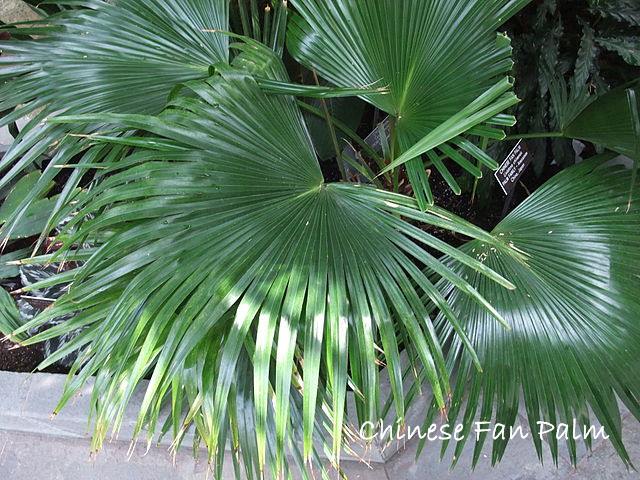Chinese Fan Palm Tree
Botanical Name: Livistona chinensis
Chinese Fan Palm is a BIG plant with sprawling fan-like fronds that grow up to 2 ft (60 cm) across.
When mature, this palm is a picture of elegance. Its broad, fan-shaped foliage is carried on tall stems, making it a graceful ornamental for the home.
You'll find that this palm is adaptable to average home temperatures and is easy to please. Treat it right and you'll enjoy your indoor palm for many years.

Chinese Fan Palm Problems, Solutions and Answers
Wondering whether to prune? Chinese fan palm doesn't need pruning to keep its shape. Never cut off its top. Unlike many plants, all new growth on palms is from the terminal tip, so cutting it off kills the stem. Older fronds may turn brown and should be removed. Cut off old fronds near the trunk, using sharp pruners. Don't pull them off, which can damage the tree.
Brown leaf tips are fairly common on indoor palms, caused by low humidity or dry soil.
Something bugging your palm? Spider mites, whiteflies, and scale insects are possible pests. Isolate an affected houseplant and treat any infestation immediately.
How to Repot Your Palm Tree
Repot in spring only when the palm becomes severely root-bound. Chinese fan palm grows slowly, so it will need repotted not more than every 3 years. To check, turn the plant on its side, slip it out of the pot and take a peek at its roots. Do the roots fill the pot? Are they coiled in the bottom of the pot? Growing out of the drainage holes? If so, it's time to repot.
Pots should be deep enough to give roots room to grow. Use a heavy pot -- although slow-growing, this palm will eventually get tall and become top-heavy.
Don't pot too deeply -- keep the top of your palm at the same soil level it was before to avoid stem rot. Also, don't spread out the roots as you repot your palm; they are brittle and break easily.
After your palm is centered in the pot, fill the potting medium around the plant and tamp it down so that it's well packed. Leave a couple inches (5 cm) from the rim to prevent it spilling out while watering.
Water your repotted palm thoroughly to settle the potting medium and add more if necessary.
Once the plant reaches the size you want, you can top-dress it instead by replacing the top couple inches of potting mix. Take care not to disturb any roots that may be near the surface.

Chinese Fan Palm Care
Origin: China, Southern Japan and Taiwan
Height: Up to 10 ft (3 m) tall in a container
Light: Bright (indirect) light year-round. Put Chinese fan palm in a bright location, but out of direct sunlight. Give it a quarter turn about once a week to expose all sides to light for even growth.
Water: Water thoroughly then allow soil to dry slightly between waterings. Water less in winter when growth has slowed. Use filtered or distilled water because tap water may contain fluoride, chlorine and other chemicals that can damage palms. When watering, avoid getting the base of the palm wet to prevent rot. Use a container with drainage holes, and fast-draining potting mix to prevent soggy soil.
Humidity: Average room (around 40-50% relative humidity). Indoor air can become extremely dry, especially in winter. It's a good idea to use a humidity monitor near your palm, rather than guess. If air is dry, use a cool-mist room humidifier. It's the most efficient way to boost humidity for your houseplants.
Temperature: 70-80°F/21-27°C days; 55-60°F/13-16°C nights. Keep your palm away from heat/AC vents and cold blasts from doorways and windows in the winter months. Your Chinese palm doesn't like dry air or cold drafts.
Soil: Mix 2 parts peat moss-based potting mix and 1 part sharp sand.
Fertilizer: Most indoor plants like a steady diet of liquid plant food, but not palms. Palms are slow-growing, especially indoors, and don't need much fertilizer. Feed with a slow-release fertilizer, such as Jobe's Indoor Palm Fertilizer food spikes once in spring and again in summer. It contains the micronutrients this palm needs to keep it lush and green.
Propagation: Sow seeds in spring, barely covering the seeds with soil. Keep them warm (75-80°F/24-27°C) using a seedling heat mat, and moist. Seeds can take 2 months to germinate, so be patient.


